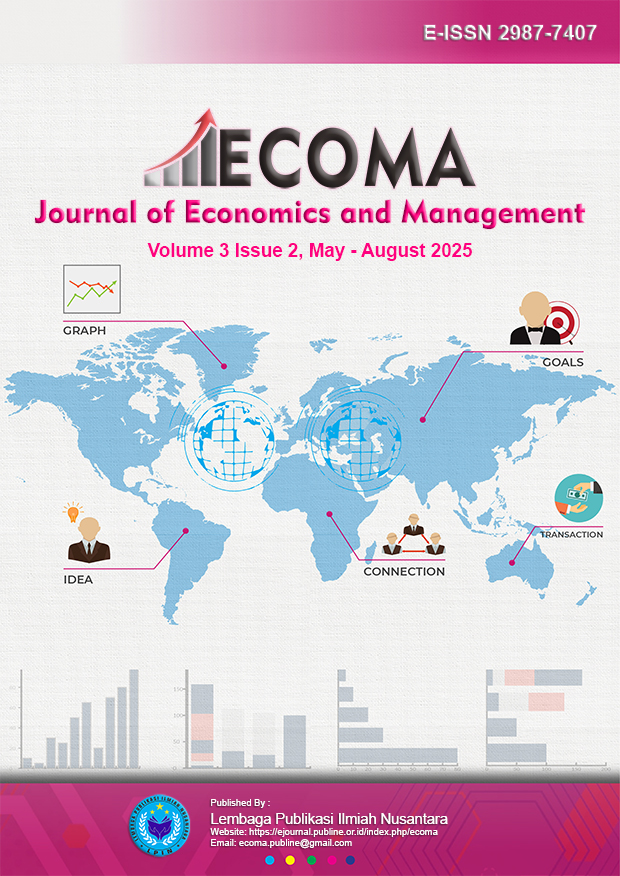Transformational Leadership and Organizational Agility in the Era of Industry 4.0
DOI:
https://doi.org/10.70716/ecoma.v3i2.250Keywords:
transformational leadership, organizational agility, industry 4.0, digital transformation, SEMAbstract
This study examines the role of transformational leadership in enhancing organizational agility within the context of Industry 4.0. As organizations face rapidly changing technological landscapes, agility becomes a critical capability for sustaining competitiveness. Using a quantitative approach, data were collected through a survey of 210 mid-level managers and supervisors across manufacturing and service industries in Indonesia. The study employs Structural Equation Modeling (SEM) to assess the relationship between four dimensions of transformational leadership idealized influence, inspirational motivation, intellectual stimulation, and individualized consideration and organizational agility. Results indicate that all dimensions of transformational leadership significantly and positively affect organizational agility, with intellectual stimulation having the strongest influence. The findings suggest that transformational leaders enable organizations to navigate uncertainty, adapt to change, and innovate continuously. This research contributes to the growing literature on agile leadership in digital transformation contexts and provides actionable insights for managers leading in dynamic environments.
Downloads
References
Alavi, S., Abd. Wahab, D., Muhamad, N., & Arbab Shirani, B. (2014). Organic structure and organisational learning as the main antecedents of workforce agility. International Journal of Production Research, 52(21), 6273–6295. https://doi.org/10.1080/00207543.2014.919420
Andersen, J. A. (2010). Public versus private managers: How public and private managers differ in leadership behavior. Public Administration Review, 70(1), 131–141. https://doi.org/10.1111/j.1540-6210.2009.02117.x
Avolio, B. J., & Bass, B. M. (2004). Multifactor leadership questionnaire: Manual and sampler set (3rd ed.). Mind Garden, Inc.
Bass, B. M. (1985). Leadership and performance beyond expectations. Free Press.
Bass, B. M., & Avolio, B. J. (1994). Improving organizational effectiveness through transformational leadership. Sage Publications.
Bennis, W., & Nanus, B. (1985). Leaders: Strategies for taking charge. Harper & Row.
Doz, Y. L., & Kosonen, M. (2010). Embedding strategic agility: A leadership agenda for accelerating business model renewal. Long Range Planning, 43(2–3), 370–382. https://doi.org/10.1016/j.lrp.2009.07.006
Drucker, P. F. (1999). Management challenges for the 21st century. Harper Business.
García-Morales, V. J., Jiménez-Barrionuevo, M. M., & Gutiérrez-Gutiérrez, L. (2012). Transformational leadership influence on organizational performance through organizational learning and innovation. Journal of Business Research, 65(7), 1040–1050. https://doi.org/10.1016/j.jbusres.2011.03.005
Judge, T. A., & Piccolo, R. F. (2004). Transformational and transactional leadership: A meta-analytic test of their relative validity. Journal of Applied Psychology, 89(5), 755–768. https://doi.org/10.1037/0021-9010.89.5.755
Jung, D. I., Chow, C., & Wu, A. (2003). The role of transformational leadership in enhancing organizational innovation: Hypotheses and some preliminary findings. The Leadership Quarterly, 14(4–5), 525–544. https://doi.org/10.1016/S1048-9843(03)00050-X
Kotter, J. P. (1996). Leading change. Harvard Business Press.
McKnight, D. H., Cummings, L. L., & Chervany, N. L. (1998). Initial trust formation in new organizational relationships. Academy of Management Review, 23(3), 473–490. https://doi.org/10.5465/amr.1998.926622
Mintzberg, H. (1973). The nature of managerial work. Harper & Row.
Nafei, W. A. (2016). Organizational agility: The key to organizational success. International Journal of Business and Management, 11(5), 296–309. https://doi.org/10.5539/ijbm.v11n5p296
Northouse, P. G. (2021). Leadership: Theory and practice (9th ed.). Sage Publications.
Rigby, D. K., Sutherland, J., & Noble, A. (2016). Agile at scale. Harvard Business Review, 94(5), 88–96.
Schein, E. H. (2010). Organizational culture and leadership (4th ed.). Jossey-Bass.
Sharifi, H., & Zhang, Z. (2001). Agile manufacturing in practice: Application of a methodology. International Journal of Operations & Production Management, 21(5/6), 772–794. https://doi.org/10.1108/01443570110390462
Teece, D. J., Peteraf, M. A., & Leih, S. (2016). Dynamic capabilities and organizational agility: Risk, uncertainty, and strategy in the innovation economy. California Management Review, 58(4), 13–35. https://doi.org/10.1525/cmr.2016.58.4.13
Tortorella, G. L., Vergara, A., Garza-Reyes, J. A., & Sawhney, R. (2019). Organizational learning paths based upon Industry 4.0 adoption: An empirical study with Brazilian manufacturers. International Journal of Production Economics, 219, 284–294. https://doi.org/10.1016/j.ijpe.2019.06.023
Tourish, D., & Pinnington, A. (2002). Transformational leadership, corporate cultism and the spirituality paradigm: An unholy trinity in the workplace? Human Relations, 55(2), 147–172. https://doi.org/10.1177/0018726702055002181
Uhl-Bien, M., & Arena, M. (2018). Leadership for organizational adaptability: A theoretical synthesis and integrative framework. The Leadership Quarterly, 29(1), 89–104. https://doi.org/10.1016/j.leaqua.2017.12.009
Van Dun, D. H., Hicks, J. N., & Wilderom, C. P. (2017). Values and behaviors of effective lean managers: Mixed-methods exploratory research. European Management Journal, 35(2), 174–186. https://doi.org/10.1016/j.emj.2016.05.001
Van Dun, D. H., & Kumar, M. (2023). Social enablers of Industry 4.0 technology adoption: Transformational leadership and emotional intelligence. International Journal of Operations & Production Management, 43(13), 152–182. https://doi.org/10.1108/IJOPM-06-2022-0370
Waldman, D. A., Javidan, M., & Varella, P. (2004). Charismatic leadership at the strategic level: A new application of upper echelons theory. The Leadership Quarterly, 15(3), 355–380. https://doi.org/10.1016/j.leaqua.2004.02.013
Wang, H., Tsui, A. S., & Xin, K. R. (2011). CEO leadership behaviors, organizational performance, and employees’ attitudes. The Leadership Quarterly, 22(1), 92–105. https://doi.org/10.1016/j.leaqua.2010.12.009
Yukl, G. A. (2013). Leadership in organizations (8th ed.). Pearson Education.
Zacher, H., & Rosing, K. (2015). Ambidextrous leadership and team innovation. Leadership & Organization Development Journal, 36(1), 54–68. https://doi.org/10.1108/LODJ-11-2012-0141
Downloads
Published
How to Cite
Issue
Section
License
Copyright (c) 2025 Yuliana Sasmita, Kevin Aditya, Sari Purnamasari, Nur Amalina Mohd Nor

This work is licensed under a Creative Commons Attribution-ShareAlike 4.0 International License.











